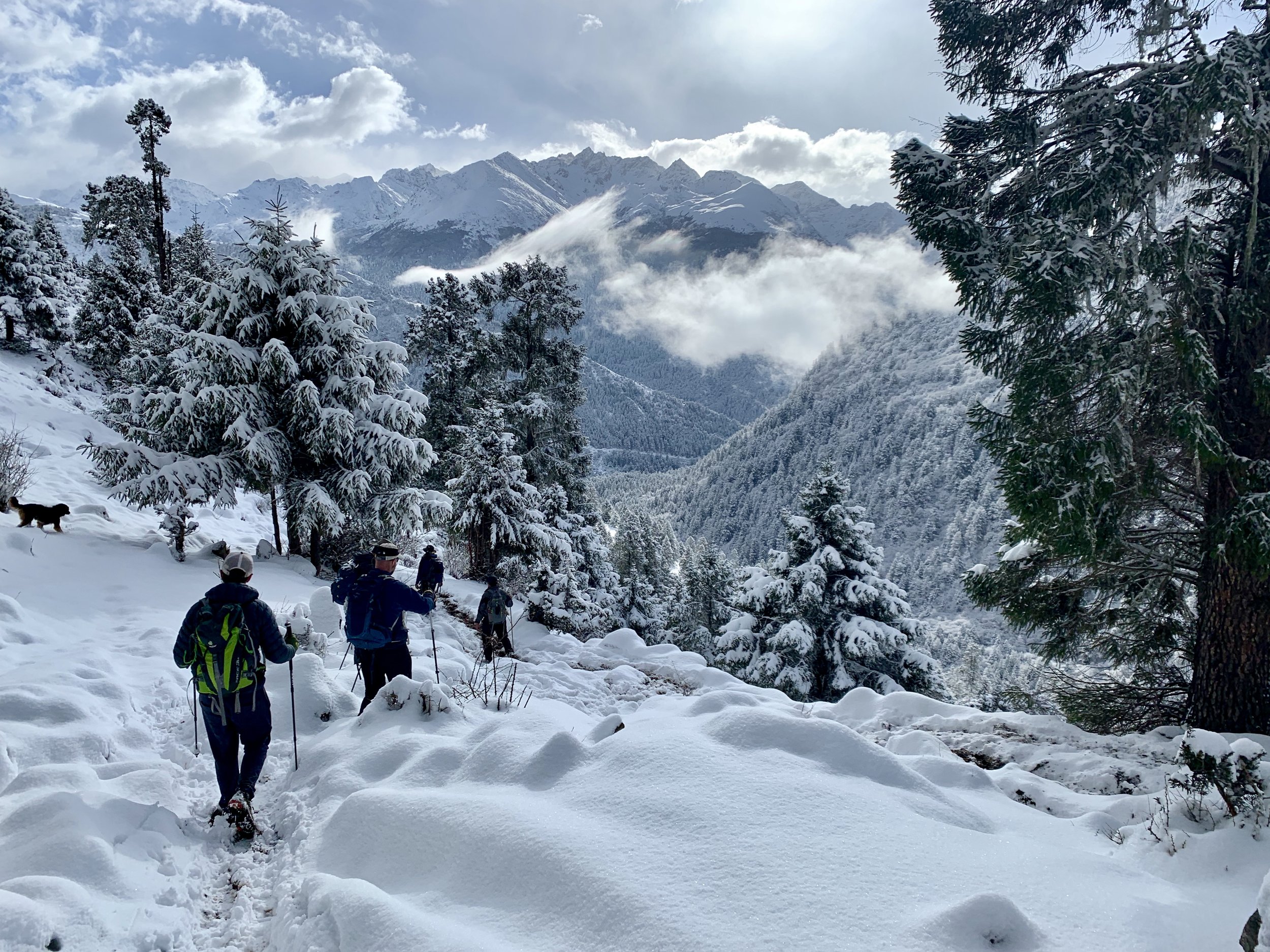If you’re interested in trekking in the Himalaya, you’re likely familiar with the options in Nepal—Everest Base Camp, the Annapurna Circuit, Poon Hill, and so on. But travellers seeking a more remote adventure with far fewer other trekkers should also keep the little kingdom of Bhutan on their radar. And in Bhutan, one of the best treks you could choose is the Laya Gasa Trek. Where is it? How hard is it? What do you need to know before you go? Read on to find out more.
The Laya Gasa Trek follows a path along Bhutan’s north-western border with Tibet, and takes 14 days to complete. Along the way you’ll see Mount Jomolhari (7,314 m.), Jichu Drake (6,989 m.) and Tsherimgang (6789 m.)
The Laya Gasa trek typically starts near Gunitsawa, a drive away from the Paro Valley. Walk a little way, then camp out for the night. The trek starts in earnest the next day. The trail climbs through conifer forests and follows a river valley. At Jangothang, have a rest day to acclimatise. Do a day hike, taking in great views of Jomolhari and Jichu Drake. The trail leads to the remote village of Lingzhi, via the Nyile La Pass (4,700 metres).
At Lingzhi, the Laya Gasa route departs from the Jomolhari trek route, which is another great trek in Bhutan. Head to Chebisa, in a picturesque valley of stone houses and pastures. Blue sheep can be spotted nearby, and you might even seek takins, the usual-looking national animal of Bhutan. (If you don’t manage to spot one on your trek, check out the Motithang Takin Preserve outside Thimphu instead).
The day in which you climb to the Sinche La Pass (5,005 metres) is the one of the hardest days of the trek. But, it’s also one of the most rewarding, with stunning views of the spectacular Tiger Mountain at the head of the valley. On a clear day, practically all mountains on the northern border between Bhutan and Tibet are visible.
Descend though beautiful forests and enter the village of Laya, home to the indigenous Layap people. The Layaps have their own language, customs and are famous for wearing traditional woven conical hats with a spike at the top. There are approximately 800 inhabitants in this remote village, which has a school, hospital, several small shops and a gompa (monastery). If you happen to be trekking in October, don’t miss the annual Royal Highlander Festival, which showcases the traditional culture of these people. It’s worth scheduling your Laya Gasa Trek especially for this time of year so you can experience the festival. (Another cultural highlight of this trek is visiting Lingshi Dzong, a hilltop fortress that has protected against invading Tibetans and Mongols for centuries.)
The trail then descends down the Mochhu River towards Gasa, renowned for its hot springs. From here, walk to the roadhead at Damji and return to Punakha.
Unlike on many of the more popular treks in neighbouring Nepal, there is no infrastructure for trekkers in Bhutan. That is, there are no cosy teahouses in which you halt for the night, take a seat in front of the brazier and order your daily dal bhat or noodle soup. No, in Bhutan trekkers must be accompanied by a full support team, and it’s necessary to camp (plus, it’s necessary for all non-Indian tourists to travel in Bhutan with a guide anyway).
The lack of infrastructure makes the Laya Gasa trek a more rugged experience than trekking in Nepal (at least, trekking the most popular routes in Nepal). But, this makes Bhutan, and the Laya Gasa trek in particular, an ideal option for travellers who have already been to Nepal, or who have trekked extensively before in other mountainous locations.
The Laya Gasa Trek does climb to some pretty high altitudes—the high passes in particular can take your breath away. Be aware of the signs of altitude sickness, and take your time. It’s important to factor a few acclimatisation days into your trip to Bhutan, so you don’t strain yourself. However, although the passes you have to cross are high, the highest camp is at around 4,140 metres. This is still high and you might feel the effects of altitude, but it’s not as high as the passes themselves.
Most days of the Laya Gasa Trek you will need to walk for around six hours, although the exact time depends on your pace. So, it’s important to be fit and prepared for this trek. You don’t need to be a superhero, but having a good level of fitness will make this trek much more enjoyable, as well as safer. If you’re not used to trekking, it’s a good idea to step up your training a few months in advance of visiting Bhutan.
The best time to undertake the Laya Gasa Trek is in the spring season (April or May) or the autumn (September or October). The conditions will be at their best at these times, with snow less likely to be a problem (although it’s always possible), and warmer temperatures. These months also coincide with the best time to travel in Nepal, and as Kathmandu is one of the few places from which you can fly to Bhutan, it makes sense to combine the Laya Gasa Trek with a few days of sightseeing in Nepal before or after.
If you’re a very experienced trekker and all of this sounds a bit too easy, the Snowman Trek is another similar option. The Laya Gasa Trek follows the first 12 days of the much harder Snowman Trek. In fact, the Snowman Trek is often called the most difficult trek in the world, because it requires camping at very high altitudes, and crossing many high passes. So, get training! (Or start with the easier Laya Gasa Trek.)
Let Beyond The Clouds organise your Laya Gasa Trek: email us at info@beyondtheclouds.org.nz











